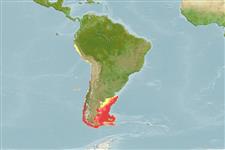Common names from other countries
Classification / Names / Names
Populärnamn | synonymer | Catalog of Fishes (gen., sp.) | ITIS | CoL | WoRMS
Environment: milieu / climate zone / depth range / distribution range
Ekologi
Bottenlevande; djupintervall 0 - 350 m (Ref. 275), usually 150 - 250 m (Ref. 106901). Subtropical, preferred 10°C (Ref. 107945); 3°S - 57°S, 81°W - 55°W (Ref. 275)
Southeast Pacific and Southwest Atlantic.
Length at first maturity / Size / Vikt / Age
Maturity: Lm ? range ? - ? cm Max length : 28.0 cm ML hane/ej könsbestämd; (Ref. 104650)
Inhabits the continental shelf (Ref. 106838). Found near the bottom. Undergoes horizontal ontogenetic migrations wherein juveniles move from spawning grounds in shallow, inshore waters at depths of 20 to 50 m, to offshore feeding grounds near the shelf edge at depths of 200 to 350 m. It then migrates back to inshore waters to spawn (Ref. 106901).
Life cycle and mating behavior
Könsmognad | Reproduktion | Lek | Ägg | Fecundity | Larver
Members of the class Cephalopoda are gonochoric. Male and female adults usually die shortly after spawning and brooding, respectively. Mating behavior: Males perform various displays to attract potential females for copulation. During copulation, male grasp the female and inserts the hectocotylus into the female's mantle cavity where fertilization usually occurs. Life cycle: Embryos hatch into planktonic stage and live for some time before they grow larger and take up a benthic existence as adults.
Roper, C.F.E., M.J. Sweeney and C.E. Nauen. 1984. (Ref. 275)
IUCN Red List Status (Ref. 130435)
CITES status (Ref. 108899)
Not Evaluated
Not Evaluated
Human uses
Fiskeri: kommersiell
FAO - fiskeri: landings, species profile | FishSource | Sea Around Us
Verktyg
Internet-källor
Estimates based on models
Preferred temperature
(Ref.
115969): 4.4 - 12.7, mean 6 (based on 72 cells).
Resiliens
Hög, lägsta populationsfördubblingstid mindre än 15 månader (K=0.07-0.9).
Prior r = 0.48, 95% CL = 0.32 - 0.72, Based on 1 data-limited stock assessment.
Vulnerability
Low vulnerability (20 of 100).
